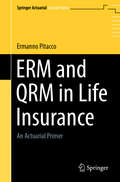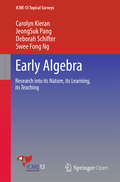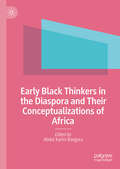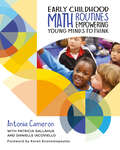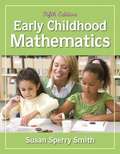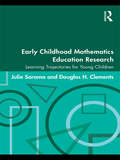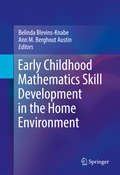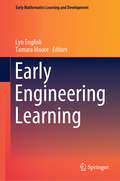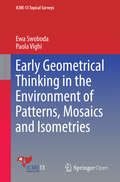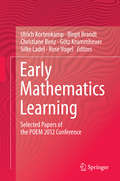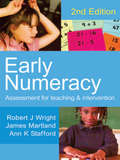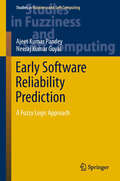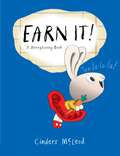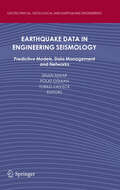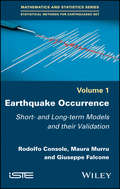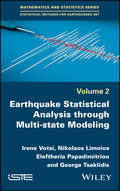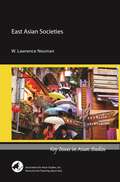- Table View
- List View
EPUBTEST 0330 - MathML in EPUB Advanced Accessibility Tests
by Math Task ForceThis is a test epub 3 file to test MathML in epub
EPUBTEST 0340 - Extended Descriptions Accessibility Tests
by Math Task Forceepub 3 test file with extended descriptions
ERM and QRM in Life Insurance: An Actuarial Primer (Springer Actuarial)
by Ermanno PitaccoThis book deals with Enterprise Risk Management (ERM) and, in particular, Quantitative Risk Management (QRM) in life insurance business. Constituting a “bridge” between traditional actuarial mathematics and insurance risk management processes, its purpose is to provide advanced undergraduate and graduate students in the Actuarial Sciences, Finance and Economics with the basics of ERM (in general) and QRM applied to life insurance business. The main topics dealt with are: general issues on ERM, risk management tools for life insurance and life annuities, deterministic and stochastic analysis of the behaviour of a portfolio fund, application of sensitivity testing to assess ranges of results of interest, stress testing to assess the impact of extreme scenarios, and the product development process for life annuity products.
ESG Investment in the Global Economy (SpringerBriefs in Economics)
by Shigeyuki Hamori Wenting Zhang Tadahiro Nakajima Xie He Guizhou Liu Yulian Zhang Tiantian LiuThis book introduces environmental, social and governance (ESG) investment and clarifies its characteristics as financial securities. It is forecasted that companies’ ESG information will be reflected in their corporate value as much as their financial information is in the future. The special feature of this book is to reveal the characteristics and impact of ESG investment using various quantitative analyses (e.g. EGARCH, asymmetric DCC, copula, VaR, connectedness, dynamic spillover). This book focuses on the relationship between some ESG indexes and the other economic variables, particularly in light of the recent economic environment (e.g. Global Financial Crisis, COIVID-19 pandemic, crude oil price crash). Readers can grasp a larger picture of ESG investment through a survey of its history and current status, predictions of its future, and interpretation of various empirical analysis results.
EU Waste Regulation in a Linear-Circular Economy Transition: Waste Management in Italy (SpringerBriefs in Environmental Science)
by Massimiliano Agovino Gaetano MusellaWaste management is a topical issue worldwide. In recent years, several requests have been made by citizens and associations to political decision-makers regarding the need for a significant improvement in waste management methods. Particularly considering the significant increase in awareness of social and environmental impacts and the economic consequences of non-virtuous waste management. There is growing attention on legislation and regulation's role in the waste sector. Regulation can help companies and citizens achieve a faster, more effective, and more efficient transition from a linear economy, based on the take-make-dispose paradigm, to a circular economy, in which the potential of waste as resources and secondary raw materials is exploited. This book is set in the wake of economic literature that tackles the transition from the linear to the circular economy. It focuses on the downstream stages of the waste management process (i.e. the waste treatment phase). In this regard, it is proposed a journey through the history of European waste legislation to study the waste sector's transition dynamics from a selfish and no longer sustainable economic model based on rampant consumerism to a far-sighted sustainable model addressing the well-being of future generations. Studying the changes in European waste regulations leads us to ask ourselves the following questions: how has waste collection changed in recent years? What are the new regulatory challenges that must be addressed to achieve the objectives of a circular economy? How successful has the EU legislation been in fostering the transition from a linear to a circular economy? Finally, has the European environmental legislation sprung a convergence process among European countries towards the circular economy, or has the definition of targets fuelled the already marked differences between EU countries?
Each Orange Had Eight Slices
by Paul GigantiThis is a counting book which teaches the child counting in an interesting manner using different objects.
Early Algebra
by Carolyn Kieran Jeongsuk Pang Deborah Schifter Swee Fong Fong NgThis survey of the state of the art on research in early algebra traces the evolution of a relatively new field of research and teaching practice. With its focus on the younger student, aged from about 6 years up to 12 years, this volume reveals the nature of the research that has been carried out in early algebra and how it has shaped the growth of the field. The survey, in presenting examples drawn from the steadily growing research base, highlights both the nature of algebraic thinking and the ways in which this thinking is being developed in the primary and early middle school student. Mathematical relations, patterns, and arithmetical structures lie at the heart of early algebraic activity, with processes such as noticing, conjecturing, generalizing, representing, justifying, and communicating being central to students engagement. "
Early Black Thinkers in the Diaspora and Their Conceptualizations of Africa
by Abdul Karim BanguraThis book argues that just as the ideas of Pan-Africanism birthed by Henry Sylvester-Williams and others in the late 1800s and Negritude ushered by Aimé Césaire and others in the early 1900s emboldened many major Black thinkers to push for independence across Africa, so will these early thinkers’ ideas help in the building of a new Africa. The various chapters explore the proposition that the thoughts of early great Diaspora Black thinkers are still wellsprings of tenets that can be used to build a new Africa. The chapters examine how these thinkers conceptualized Africa in their works, with the main objective of delineating their conceptualizations to generate suggestions on how to build a new Africa.
Early Childhood Math Routines: Empowering Young Minds to Think
by Antonia Cameron Patricia Gallahue Danielle IacovielloOne of the many challenges facing early childhood teachers is how to meet academic standards while creating learning environments that honor young children&’s mathematical curiosity. In Early Childhood Math Routines Empowering Young Minds to Think, author Toni Cameron introduces us to a set of short whole-group and partner routines designed to engage young children in meaningful math thinking and build problem-solving communities. With contributions from Patricia Gallahue and Danielle Iacoviello, Cameron reimagines traditional math routines and introduces brand new routines that focus on the important mathematical ideas of early childhood. Through stories, classroom examples, and resources, Cameron offers you the tools to get started right away with these routines. Inside you'll find the following resources: Innovative routines of student-teacher dialogue and teaching analysis to support you in planning and facilitating; Clear explanations of the big mathematical ideas in early childhood math; Access to a robust companion website which includes; downloadable and printable cards/gameboards, over 30 slide decks for facilitating routines, additional practice routines, supplemental readings, and a place value interview assessment; A day-by-day suggested planning guide to introducing and developing each routine in your classroom; Learn from Cameron's experience supporting the complexities of early childhood mathematics while also building communities that foster social, emotional, and cognitive development in young children. Get the tools and routines that will help you connect children to mathematics in a way that is exciting and powerful.
Early Childhood Mathematics
by Susan Sperry SmithEarly Childhood Mathematics, Fifth Edition is the most widely used guide for educators on teaching mathematics to young children in Kindergarten through Third Grade. Practical and applied, this trusted and research-based book encourages teachers and teacher candidates to create an active learning environment that fosters curiosity, confidence, and persistence in children learning mathematics. Expert author, Susan Sperry Smith relies heavily on the most current research in the field, aligns core content to the NCTM Standards, presents information on Cognitive Guided Instruction (CGI) and necessary adaptations for students with special needs. The book covers the most important key concepts for teaching math in the early years with three over-arching themes: knowledge of important mathematical relationships, number sense, and the ability to solve problems. The fifth edition builds on the reliability and excellency of previous editions with new information on meeting the educational needs of all students, the importance of STEM careers beginning in early childhood education, more activities, thematic unit, and curricular tools, multicultural literature and activities, a comprehensive update on The Common Core State Standards, NAEP, and the new DAP Position Statement.
Early Childhood Mathematics Education Research: Learning Trajectories for Young Children (Studies in Mathematical Thinking and Learning Series)
by Douglas H. Clements Julie SaramaThis important new book synthesizes relevant research on the learning of mathematics from birth into the primary grades from the full range of these complementary perspectives. At the core of early math experts Julie Sarama and Douglas Clements's theoretical and empirical frameworks are learning trajectories—detailed descriptions of children’s thinking as they learn to achieve specific goals in a mathematical domain, alongside a related set of instructional tasks designed to engender those mental processes and move children through a developmental progression of levels of thinking. Rooted in basic issues of thinking, learning, and teaching, this groundbreaking body of research illuminates foundational topics on the learning of mathematics with practical and theoretical implications for all ages. Those implications are especially important in addressing equity concerns, as understanding the level of thinking of the class and the individuals within it, is key in serving the needs of all children.
Early Childhood Mathematics Skill Development in the Home Environment
by Belinda Blevins-Knabe Ann M. Berghout AustinThis volume presents current research on the connections between the home and family environment on children's mathematics development. Focusing on infancy through first grade, it details the role of parents and other caregivers in promoting numeracy and the ways their active participation can prepare young children for learning about formal mathematics. Research data answer key questions regarding the development of numeracy alongside cognitive and linguistic skills, early acquisition of specific math skills, and numeracy of children with atypical language skills. The book also provides practical recommendations for parents and other caregivers as well as implications for future research studies and curriculum design. Included in the coverage: Ways to optimize home numeracy environments. Individual differences in numerical abilities. Cross-cultural comparisons and ways to scaffold young children's mathematical skills. Mathematics and language in the home environment. Center-based and family-based child care. Games and home numeracy practice. Early Childhood Mathematics Skill Development in the Home Environment is an essential resource for researchers, graduate students, and professionals in infancy and early childhood development, child and school psychology, early childhood education, social work, mathematics education, and educational psychology.
Early Engineering Learning (Early Mathematics Learning And Development Ser.)
by Lyn English Tamara MooreThis book addresses engineering learning in early childhood, spanning ages 3 to 8 years. It explores why engineering experiences are important in young children's overall development and how engineering is a core component of early STEM learning, including how engineering education links and supports children's existing experiences in science, mathematics, and design and technology, both before school and in the early school years.Promoting STEM education across the school years is a key goal of many nations, with the realization that building STEM skills required by societies takes time and needs to begin as early as possible. Despite calls from national and international organisations, the inclusion of engineering-based learning within elementary and primary school programs remains limited in many countries. Engineering experiences for young children in the pre-school or early school years has received almost no attention, even though young children can be considered natural engineers.This book addresses this void by exposing what we know about engineering for young learners, including their capabilities for solving engineering-based problems and the (few) existing programs that are capitalising on their potential.
Early Geometrical Thinking in the Environment of Patterns, Mosaics and Isometries
by Ewa Swoboda Paola VighiThis book discusses the learning and teaching of geometry, with a special focus on kindergarten and primary education. It examines important new trends and developments in research and practice, and emphasizes theoretical, empirical and developmental issues. Further, it discusses various topics, including curriculum studies and implementation, spatial abilities and geometric reasoning, as well as the psychological roots of geometrical thinking and teacher preparation in geometry education. It considers these issues from historical, epistemological, cognitive semiotic and educational points of view in the context of students' difficulties and the design of teaching and curricula.
Early Mathematical Explorations
by Deborah Butler Nicola Yelland Carmel DiezmannEarly Mathematical Explorations shows readers how to provide young children with rich mathematical learning environments and experiences. This book presents teachers with a sound theoretical framework to encourage children to become numerate in the 21st century. It shows that mathematical learning can occur in a variety of ways, including when children explore ideas through play, problem solving and problem posing; engage in a rich variety of multimodal learning experiences; pursue self-directed activities and cooperate with others; and make connections between ideas and experiences in their everyday worlds. Chapters 2 and 3 explore the ways in which mathematical understandings can be supported from birth to five years. Chapters 4-9 provide an overview of mathematics in the early primary years. The final chapters illustrate the contexts and connections that can be made in early mathematical learning. Early Mathematical Explorations is an essential resource for pre- and in-service teachers alike.
Early Mathematics Learning
by Ulrich Kortenkamp Birgit Brandt Christiane Benz Götz Krummheuer Silke Ladel Rose VogelThis book will gather current research in early childhood mathematics education. A special focus will be the tension between instruction and construction of knowledge. The book includes research on the design of learning opportunities, the development of mathematical thinking, the impact of the social setting and the professionalization of nursery teachers.
Early Numeracy: Assessment for Teaching and Intervention (Math Recovery)
by Ann K Stafford Robert J Wright Mr James Martland'Unlike many books based on research work this book doesn't just let teachers know what is going wrong with children's learning it actually gives some practical advice about what to do next. The whole book is based upon extensive observation and recording of individual children and their difficulties with mathematics. These children are the most difficult to plan for in a busy classroom and the authors appreciate the small steps and the different learning styles approaches needed for these children. This approach fits well with the NNS wave and springboard materials but takes the analysis of the individual's difficulties to a more detailed level. The book brings together research carried out across a range of countries and therefore shows the versatility of the approaches taken. This will be a very useful book for trainee teachers as it exemplifies how to use assessment to feed into teaching. It will be helpful for class teachers and mathematics co-ordinators as well as SENCOs to assist in improving the teaching and learning for specific children in our schools' - Mary Briggs, Primary and Early Years PGCE Co-ordinator, Institute of Education, University of Warwick 'This is a highly practical resource that will be appreciated by classroom and specialist teachers alike. It will provide teachers new to the Math Recovery program with practical help and support to diagnose errors and misconceptions in early numeracy. Practicing Math Recovery Specialists will be thrilled with the addition of four new highly focused assessments and an elaboration of the Learning Framework in Number. Early Numeracy is admirably grounded in international research and well-established theory, characteristics that are much sought after in the current data driven educational environment. Like many others, I was drawn to Math Recovery after reading the first edition of Early Numeracy. This second edition is a treasure - it is exciting to consider the impact it will have on children and teachers, and to the growth of the Math Recovery program' - Audrey Murray, Lead Teacher, Midwest Math Recovery Training Center, Minneapolis This text has been fully updated to include developments and refinements brought about by widespread international application of the assessment tools in the Mathematics Recovery Programme. The book will help practitioners to identify and provide detailed analyses of all children but especially those who are able and those who underachieve in early numeracy. It will enable teachers, learning support personnel, numeracy consultants and educational psychologists to advise colleagues and parents on children's number knowledge and strategies for early numeracy. The Mathematics Recovery Programme has been successfully applied in Australia, the United Kingdom and Ireland, the United States and Canada, both in specialist interventions and classroom settings. The revised version shows how familiarisation with, and understanding of, the diagnostic assessment tools has allowed teachers to become more knowledgeable in understanding children's difficulties and misconceptions, and more skilled and confident in planning programmes of intervention and monitoring the children's progress. This new edition includes: - Integrated frameworks of useful tasks for assessing children's number knowledge and strategies; - Four separate and revised diagnostic assessment interviews; - Assessments for addition and subtraction strategies, Base Ten Arithmetical strategies, Early Grouping strategies, and Advanced Grouping strategies in the four operations; - How the assessment process has impacted significantly on teachers' professional development and contributed to the raising of standards in early numeracy.
Early Software Reliability Prediction: A Fuzzy Logic Approach
by Ajeet Kumar Pandey Neeraj Kumar GoyalThe development of software system with acceptable level of reliability and quality within available time frame and budget becomes a challenging objective. This objective could be achieved to some extent through early prediction of number of faults present in the software, which reduces the cost of development as it provides an opportunity to make early corrections during development process. The book presents an early software reliability prediction model that will help to grow the reliability of the software systems by monitoring it in each development phase, i.e. from requirement phase to testing phase. Different approaches are discussed in this book to tackle this challenging issue. An important approach presented in this book is a model to classify the modules into two categories (a) fault-prone and (b) not fault-prone. The methods presented in this book for assessing expected number of faults present in the software, assessing expected number of faults present at the end of each phase and classification of software modules in fault-prone or no fault-prone category are easy to understand, develop and use for any practitioner. The practitioners are expected to gain more information about their development process and product reliability, which can help to optimize the resources used.
Earlybird Kindergarten Mathematics, Textbook, A, Standards Edition
by Winnie Tan Yeap Ban HarNIMAC-sourced textbook
Earn It! (A Moneybunny Book)
by Cinders McLeodIn this delightful introduction to the simple concept of earning money, an exuberant little bunny learns that fame and fortune must be earned. Bun wants to be rich and famous. She loves to sing and knows she&’s meant for a career on stage. It should all be pretty easy—her mom can just drive her to the concert hall to perform! But her mom reminds her that most good things, like the garden they are growing, take time and work. At first, Bun isn&’t terribly excited by the idea of singing lessons and practice, but as she does the math and daydreams about her future singing career, the more she starts to like the idea of earning her way to stardom—a feeling just as good as being rich and famous!
Earth Science Reference Tables Workbook 4th Edition
by Topical Review Book CompanyThis workbook correlates with the current New York State Physical Setting Earth Science Reference Tables. Each table has its own section. Each section contains a detailed overview of the material, additional information, and a series of related practice questions.
Earthquake Data in Engineering Seismology
by Polat Gülkan Sinan Akkar Torild Van EckThis book addresses current activities in strong-motion networks around the globe, covering issues related to designing, maintaining and disseminating information from these arrays. The book is divided into three principal sections. The first section includes recent developments in regional and global ground-motion predictive models. It presents discussions on the similarities and differences of ground motion estimations from these models and their application to design spectra as well as other novel procedures for predicting engineering parameters in seismic regions with sparse data. The second section introduces topics about the particular methodologies being implemented in the recently established global and regional strong-motion databanks in Europe to maintain and disseminate the archived accelerometric data. The final section describes major strong-motion arrays around the world and their historical developments. The last three chapters of this section introduce projects carried out within the context of arrays deployed for seismic risk studies in metropolitan areas. Audience: This timely book will be of particular interest for researchers who use accelerometric data extensively to conduct studies in earthquake engineering and engineering seismology.
Earthquake Occurrence: Short- and Long-term Models and their Validation
by Giuseppe Falcone Maura Murru Rodolfo ConsoleEarthquake Occurrence provides the reader with a review of algorithms applicable for modeling seismicity, such as short-term earthquake clustering and pseudo-periodic long-term behavior of major earthquakes. The concept of the likelihood ratio of a set of observations under different hypotheses is applied for comparison among various models. In short-term models, known by the term ETAS, the occurrence space and time rate density of earthquakes is modeled as the sum of two terms, one representing the independent or spontaneous events, and the other representing the activity triggered by previous earthquakes. Examples of the application of such algorithms in real cases are also reported. Dealing with long-term recurrence models, renewal time-dependent models, implying a pseudo-periodicity of earthquake occurrence, are compared with the simple time-independent Poisson model, in which every event occurs regardless of what has occurred in the past. The book also introduces a number of computer codes developed by the authors over decades of seismological research.
Earthquake Statistical Analysis through Multi-state Modeling
by Nikolaos Limnios Irene Votsi Eleftheria Papadimitriou Georgios TsaklidisEarthquake occurrence modeling is a rapidly developing research area. This book deals with its critical issues, ranging from theoretical advances to practical applications. The introductory chapter outlines state-of-the-art earthquake modeling approaches based on stochastic models. Chapter 2 presents seismogenesis in association with the evolving stress field. Chapters 3 to 5 present earthquake occurrence modeling by means of hidden (semi-)Markov models and discuss associated characteristic measures and relative estimation aspects. Further comparisons, the most important results and our concluding remarks are provided in Chapters 6 and 7.
East Asian Societies
by W. Lawrence NeumanSo very many teach introductions to East Asia under different disciplines, including the Humanities, Sociology, Economics, History, and Religious Studies, but what makes this work so promising is its transferability across these lines of demarcation for the student engaged in her first serious study of the region. Neuman’s fine overview addresses the recurring cultural tasks across East Asia from family, to school and work, and socio-economic stratifications. Neuman has written an ideal introductory text with a sociologist’s clarity, a humanist’s learning, a researcher’s sharp eye, and a teacher’s fine sense of proportion. This is the only intellectual guidebook you will need to take with you for your voyage to East Asia.

